HISTORY AND ACHIEVΕMENTS OF THE KYRENIA FOLKLORE SOCIETY
Theophano Chiotelli Kypri
Kyrenia 1966 – 1974
In the mid 60’s the town of Kyrenia not only enjoyed an increased number of tourists but it also demonstrated a remarkable intellectual and cultural activity. The Greek Cypriot inhabitants of Kyrenia, proud of their town’s long history and traditions and its natural beauty, they tirelessly worked towards upgrading their town through collective or private initiatives and activities in all sectors of social life, and in particular the cultural aspect of the town’s everyday life.
In October 1966, a group of Kyrenians out of love for their town and inspired by the rich folk tradition, took the initiative to establish a Founding Committee in order to create the Kyrenia Folklore Society. Their vision was to establish a Society whose main objective would be to save a precious piece of the soul of Kyrenia, namely, its folk tradition as this was passed on throughout many centuries and across generations. Kyrenia, both the town and the homonymous district, with its antiquities, its Byzantine churches and its exceptional medieval monuments, all of which bear witness to long Hellenic tradition, dating back to antiquity and enriched through the centuries with various elements, depending on the historic adventures and the political, social and cultural conditions prevailing from time to time on the island.
Members of the Founding Committee were Rina Katselli Secretary, Elli Stavrou, Eleni Soteropoulou, Kyriakos Charalambides, Ioulia Makridou, Yiannoulla Hadjilampi and Faedros Fieros. During the first three preliminary meetings of the Committee it was determined that the name of the Society would be ‘Kyrenia Folklore Society’ and its emblem would be a well-known folk pattern, the Cypress tree, as this is engraved on traditional cypriot wood carvings. The Committee also requested that the new Society be placed under the auspices of the Kyrenia Municipality, and this was indeed approved.
The Founding Assembly was held on 30 October 1966 in the presence of a large number of Kyrenians. The first Council elected comprised: Nikos Chiotellis, President Costas Christodoulides, Vice President, Rina Katselli, secretary, Maroulla Sotiropoulou, second secretary, Kiki Costambey, Treasurer, Elli Stavrou, second treasurer and Ioulia Makridou, Clerk.
Immediately after the establishment of the Folklore Society, the Council strongly convinced that by getting acquainted with the folk culture of their home land, people get better acquainted with their identity and their roots, began to organise the first events, fully aware of the significance of the work it was undertaking and the need for a joint effort in order to materialise their vision. The first event was held at the Dome Hotel on 26 November 1966.
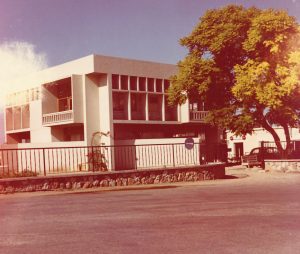
From the very beginning all events organised by the Folklore Society were a great success, and won the hearts and respect of the people of Kyrenia. Most events were held at the Dome Hotel. During the first years, the Folklore Society was accommodated at the Dome hotel in a room kindly made available by the owners and later in 1969, acquired its new permanent premises at the newly built Municipal Hall. The Municipal Council headed by the Mayor Stelios Katsellis strongly supported the new Society. The same support was provided by Kyrenia Gymnasium Headmaster Athanasios Meremetis, the headmaster of the primary school Christakis Christodoulides and the President and members of the School Committee of the Greek Schools of Kyrenia.
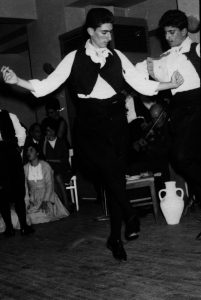 The first organised event included Cyprus folklore dancing and Greek national dancing performed by the Society’s dance club, under the direction Kyriakos Charalambides, Yiannoulla Hadjilambi and Eleni Sotiropoulou.
The first organised event included Cyprus folklore dancing and Greek national dancing performed by the Society’s dance club, under the direction Kyriakos Charalambides, Yiannoulla Hadjilambi and Eleni Sotiropoulou.
From the very beginning, the Society had an active and substantial role in the organising of the celebrations for Whit Monday (Kataklysmos Fair). Whit Monday was an important popular traditional fair in Kyrenia, celebrated with lots of events, beginning from the previous Saturday (All Souls’ day), through to Sunday (Pentecost) and culminated on Monday (Whit Monday) best known as Kataklysmos. They used to celebrate the holy sea with lots of water sport competitions on Sunday afternoon, and on Whit Monday evening a large celebration was held with folk dancing and tsiattismata (lively, impromptu oral poetry performed in Greek Cypriot dialect whereby one poet-singer attempts to outdo another with clever verses of rhyming couplets). Since 1960 these celebrations were under the auspices of the Kyrenia Municipality in cooperation with the other Societies of the town.
Since its establishment, the Kyrenia Folklore Society began a campaign for cultivating public interest on the folkloric culture and arousing the interest and involvement of the people of the town in its efforts towards preserving folkloric tradition and art.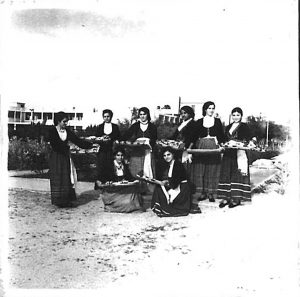
The Kyrenia Folklore Society very often called on Kyrenians to record and to hand over to the Society any material they had on folklore intellectual works (poems, tsiattista (Cypriot folk songs), customs and proverbs) place names, old customs and traditions.
In this same spirit members of the Society taught traditional wood carving which in the past had flourished in the Kyrenia district.
Furthermore, from the very first year of its establishment, the Society, put much effort towards setting up a Folk Art Museum in Kyrenia. One year later, in 1968, its efforts paid off and Kyrenia acquired its own Folk Art Museum, the first one in Cyprus established by the Department of Antiquities and accommodated in a building granted by a British Lady, Mrs Margaret Loch, at the Kyrenia Harbour. Members of the Folklore Society worked together with the competent Antiquities Officer Angeliki Pieridou for organising the exhibits.
Over and above the folkloric events, the Society gradually extended its activities to other cultural events. Under the patronage of the Kyrenia Municipality the Society carried out and assumed the largest part of the intellectual and artistic activities of the Municipality, such as literary afternoon teas, music nights with concerts, violin and piano recitals, book exhibitions, painting exhibitions, the children’s masquerade carnival and the fancy dress parade etc., which were always very successful and had high turn outs. In July 1968 a summer carnival was held for the first time in the Kyrenia Castle, in an effort to establish a summer event in the small town, under the patronage of the Kyrenia Municipality.
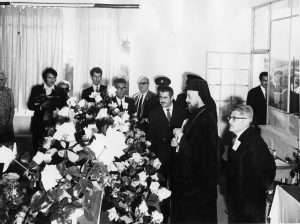 However, the most successful event organised by the Kyrenia Folklore Society, was the Flower Show established in 1967 and held annually from there on until the Turkish occupation in 1974. The idea was taken from a similar event organised by the British residents of Kyrenia in the 50’s following the example of the Chelsey Flower Show. Flower exhibits included pots with flowers and other plants, cut flowers in vases, floral arrangements, dried flower arrangements and vegetables. The best exhibits were awarded by the selection panel. Besides flowers, there were 60 different kinds of exhibits and competitions such as embroidery, underwater photographs etc. Alongside, various other exhibitions were organised such as an exhibition on old books about Kyrenia, of folk art, painting, pottery, sculpture, Cyprus rock formations. Cyprus dances and songs were also performed in the schoolyard. The Annual “Flower Show Programmes” published by the Society are a great source of information containing all details regarding the organising of this important event and which enjoyed high public interest island wide. The British residents of Kyrenia at the time were actively involved in all aspects of the organisation of the Flower Show (Mr D.M.Homan, Mrs M.Drake, Mr A. MacMorran, Lt. Col. A. T. Simonds, Mrs I. Spinney, Lady M. Blackall, Mrs L. Mathews, Mrs S. Cusack, Mrs M. Farley, Mrs Marshall, Mr and Mrs Hurst, Mrs K. Bowles, Mr William Dreghorn, Mr E. Twyman, Mrs Grey, Dr. Cohen, Mr & Mrs Humphrey, Mrs Hartley and others).
However, the most successful event organised by the Kyrenia Folklore Society, was the Flower Show established in 1967 and held annually from there on until the Turkish occupation in 1974. The idea was taken from a similar event organised by the British residents of Kyrenia in the 50’s following the example of the Chelsey Flower Show. Flower exhibits included pots with flowers and other plants, cut flowers in vases, floral arrangements, dried flower arrangements and vegetables. The best exhibits were awarded by the selection panel. Besides flowers, there were 60 different kinds of exhibits and competitions such as embroidery, underwater photographs etc. Alongside, various other exhibitions were organised such as an exhibition on old books about Kyrenia, of folk art, painting, pottery, sculpture, Cyprus rock formations. Cyprus dances and songs were also performed in the schoolyard. The Annual “Flower Show Programmes” published by the Society are a great source of information containing all details regarding the organising of this important event and which enjoyed high public interest island wide. The British residents of Kyrenia at the time were actively involved in all aspects of the organisation of the Flower Show (Mr D.M.Homan, Mrs M.Drake, Mr A. MacMorran, Lt. Col. A. T. Simonds, Mrs I. Spinney, Lady M. Blackall, Mrs L. Mathews, Mrs S. Cusack, Mrs M. Farley, Mrs Marshall, Mr and Mrs Hurst, Mrs K. Bowles, Mr William Dreghorn, Mr E. Twyman, Mrs Grey, Dr. Cohen, Mr & Mrs Humphrey, Mrs Hartley and others).
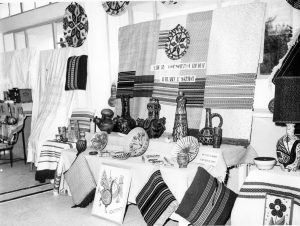 The Society endeavoured to tighten relations between its members and to this end they organised excursions to various places of folkloric, historic or religious interest in order to give them the chance to get acquainted with Cyprus. Among the sites they visited were the village of Lefkara, the Byzantine Church of Asinou, the Stavrovouni Monastery, St.George Alamanos Monastery and others.
The Society endeavoured to tighten relations between its members and to this end they organised excursions to various places of folkloric, historic or religious interest in order to give them the chance to get acquainted with Cyprus. Among the sites they visited were the village of Lefkara, the Byzantine Church of Asinou, the Stavrovouni Monastery, St.George Alamanos Monastery and others.
Since 1967 the Society began to publish its own mouthpiece, the Bulletin of the Kyrenia Folklore Society. During the first years it was published with the help of duplicators due to lack of financial means. Four Bulletins were published up to the Turkish Invasion, rich in information regarding folklore, such as folk songs of Cyprus, folk poetry, legends and local traditions, issues on the language particularities in the Kyrenia district and others. These Bulletins also included historical research relating to issues concerning Kyrenia. One can follow in detail the activities of the Society through these publications and everything concerning the function of the Society. They also include speeches, election procedures, annual reports, honorary members, names of donours and benefactors, new members and much more.
The first publications of the Society were published in duplicated copies in1969. The first publication was the “Book of people born in Kyrenia 1880 -1905, in a manuscript written by Priest Yiannis Paphitis. Currently, with Kyrenia under Turkish occupation and all records lost, this work, which has since been published in printed form, is a valuable and irreplaceable source of information regarding the families of Kyrenia during that period. Another significant publication was the edition How to engrave a Cyprus chest. A guide for Cyprus woodcarving, written by Rina Katselli, and later on there were more publications until 1973. A complete list of the publications of the Kyrenia Folklore Society is published in another section.
In 1973 the first printed edition of the Society, titled Kyrenia – a Historical Study, written by Rina Katselli, was published with the contribution of the geologist William Dreghorn (geological and medieval monument sketches) May Micheson and Robin Nights (translation into English) and D.M. Homan. This is an emblematic book dealing with Kyrenia and valuable information concerning historical and folklore information and photographs published in a year considered to be a landmark for the town and its people, as one year later, in 1974, the tragedy of the brutal Turkish invasion ended with the occupation of Kyrenia by the Turkish armed forces, and the uprooting of the Greek residents of the town from their homeland followed by the terrible consequences on peoples’ lives, their civilization and traditional folk culture.
Nicosia 1974-
A few years after the Turkish invasion and the violent displacement of the lawful Greek Cypriot inhabitants of Kyrenia, the town’s Folklore Society, with a strong sense of debt to the native city and its culture, was reactivated in exile in Nicosia.
Initially, in 1983, it was housed in the refugee settlement of Agios Mamas in Lakatamia in premises allotted by the government. By invitation of Secretary Rina Katselli, the Board of Directors was regrouped and started to plan their activities with enthusiasm and determination to continue the work which was so successfully performed in Kyrenia. Its priority was to reconnect the people of Kyrenia and to inspire confidence and to motivate them after so much suffering brought about by the Turkish invasion and their uprooting. So, as a first event, it was decided to organise once again the Fair of Panagia Glytziotissa (Virgin Mary the Savior) on 8 September, which was always the most popular folk festival in the whole district of Kyrenia, before the Turkish invasion. The Chapel of Virgin Mary was close to Kyrenia, to the west, by the sea, and had always been a regular pilgrimage for local residents.
In 1989 the Folklore Society was housed in the Kyrenia Town Hall in a building at 9 Othello Street in the walled city of Nicosia, near Famagusta Gate, and in April 2003 it was moved to no.8 Markos Drakos Street, together with the Town Hall, granted by the Government near the historic Ledra Palace Hotel. The support and assistance always provided by the Mayor, the City Council of Kyrenia and the secretarial staff of the municipality was constant and very substantial.
From the very first meeting of the Society following the re-organisation of the Municipal Council and with the participation of several other members it was decided that the Society should focus on the publication of books referring to the history and culture of Kyrenia in order to preserve its historical memory. It was decided that primary concern should be the preservation and publication, through private and public archives and through scientific research, of all those data and information which would bring together younger people to the land of their ancestors, to their roots and culture and to preserve their undying desire for return to their home town. The Book Kyrenia – A Historical, Folkloric Research had been republished in 1979 by the writer and then secretary of the Society. A high quality book production followed, with a series of many valuable publications on Kyrenia referring to the history, folklore, literature, the art and the life and work of significant persons of the town.
Books were initially presented at events which were organised at the Famagusta Gate with remarkable participation by Kyrenians and friends of Kyrenia who reminisced the moments and good old times in their small beautiful city.
Later on, it was decided that new publications of the Kyrenia Folklore Society would be presented every year in an event organised by the Kyrenia Municipality and the School Committee on the day of the Three Hierarchs, which is also celebrated as the day of Greek letters. It must be noted that all publications are available both in Cyprus and overseas by the non-profit publishing firm “Chrysopolitissa”, together with its own publications. Almost all publications are related to Kyrenia.
The Kyrenia Folklore Society, was re-registered as a Society in accordance with the Societies and Institutions Law, on 9 October 2006 and acquired the relevant certificate.
In November 22, 2014 the Kyrenia Folklore Society was honoured by the Greek Cultural Society of Cypriots living in Greece with the “EPOC CABBY AWARDS-CYPRUS-GREEK Best and Brightest of the year 2014” award, for its significant contribution and action. The award was presented at a ceremony held at the Athens War Museum auditorium. The author and person in charge of the Society’s publications Mrs Rina Katselli was also awarded during the same event.
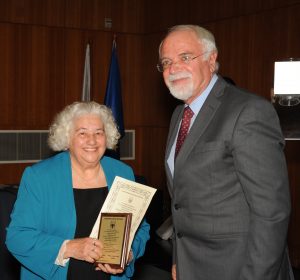 In November 2016 the Society celebrated in exile its fifty years of existence, at a special event during which Bulletin 6 “Fifty Years of Life, 1966-2016 “was presented.
In November 2016 the Society celebrated in exile its fifty years of existence, at a special event during which Bulletin 6 “Fifty Years of Life, 1966-2016 “was presented.
In evaluating the action and the contribution of the Kyrenia Folklore Society during the past fifty years, one must point out the cultural and national importance which highlighted its work, which in its entirety is a valuable legacy for the next generations. Today, the universal recognition of the value of this work fully justifies the expectations of its founders, and the years of effort and hard work on the part of all the active members, the respective Presidents and Council members and their associates and pays tribute to them and their work. *
